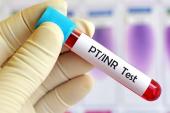Lower Dose of Edoxaban Supported in ENGAGE-AF-TIMI 48 Analysis
Even so, the approved higher dose remains the standard therapy for the vast majority of patients, the researchers say.

The lower dose of edoxaban (Savaysa; Daiichi-Sankyo) evaluated in ENGAGE AF-TIMI 48 provides a net clinical benefit, according to a new analysis of the trial, suggesting it may be useful for some patients with atrial fibrillation (AF).
The trial evaluated two doses of the direct oral anticoagulant (DOAC) versus warfarin—60 and 30 mg once daily; both could be cut in half in patients meeting certain criteria. The rate of a net clinical outcome incorporating stroke/systemic embolism, major bleeding, or death was significantly lower in patients who received the lower- versus higher-dose regimen (7.26% vs 8.01%; HR 0.90; 95% CI 0.84-0.98).
However, there was a trade-off with the lower dose—it was associated with a greater risk of stroke/systemic embolism compared with the higher dose but with reduced risks of major, intracranial, GI, and life-threatening bleeding.
Though the researchers, led by Jan Steffel, MD (University Heart Center Zurich, Switzerland), conclude that the approved higher-dose regimen “remains the standard therapy” for stroke prevention in patients with AF, they indicate that these findings might be helpful for physicians considering whether to use the lower dose in select cases.
Deliberate use of lower-than-recommended doses of DOACs, usually related to concerns about bleeding, is widespread in practice, senior author Robert Giugliano, MD (Brigham and Women’s Hospital, Boston, MA), told TCTMD. And it’s been associated with worse outcomes. But physicians are largely in an “evidence-free zone” when they do so, he pointed out, because only two of the pivotal DOAC trials—RE-LY and ENGAGE AF-TIMI 48—evaluated more than one dose of the study drug (not counting dose reductions according to prespecified criteria).
“For the majority of patients, they ought to continue to receive the approved dosing regimen, the higher-dose regimen, according to the label,” Giugliano said about edoxaban. “But we all inevitably run into patients in clinical practice who are either very risk averse to bleeding or very high risk for bleeding.”
In those cases, and after a discussion about the potential risks (increased stroke) and benefits (less bleeding) with the patient, it might be decided that the lower dose is the way to go, Giugliano said. “It’s just a question of what your tolerance is for a bleed versus a stroke and what the patient’s risk is,” he explained, but reiterated, “I think the vast majority of patients should receive the standard approved dose.”
More Stroke, Less Bleeding With Lower Dose
Acknowledging that use of lower-than-recommended doses of the DOACs is common out in practice, the investigators decided to compare the two edoxaban dosing regimens from ENGAGE AF-TIMI 48. The trial randomized 21,105 patients with AF and a moderate-to-high risk of stroke to warfarin or one of two edoxaban doses. Both the 60- and 30-mg doses of the DOAC were cut in half in patients who had moderate renal insufficiency, had a body weight of 60 kg or less, or were using a strong P-glycoprotein inhibitor.
I think 90% or more of the patients should get the standard dose, but there are some individuals where it may make good medical sense to use a reduced dose. Robert Giugliano
The main results showed that both doses were noninferior to warfarin in terms of stroke or systemic embolism, with less major bleeding and cardiovascular death with the DOAC. The lower-dose edoxaban regimen carried a higher risk of ischemic stroke compared with warfarin but a lower risk of all-cause death, “raising the possibility that this dosing regimen might be beneficial for certain patient profiles,” Steffel et al say.
In the current analysis, published in the March 9, 2021, issue of the Journal of the American College of Cardiology, the researchers evaluated three net clinical outcomes:
- Primary: stroke/systemic embolism, major bleeding, or death
- Secondary: disabling stroke, life-threatening bleeding, or all-cause mortality
- Tertiary: stroke/systemic embolism, life-threatening bleeding, or all-cause mortality
The primary net clinical outcome slightly but significantly favored the lower versus higher dose of edoxaban, whereas there were no differences between dosing regimens for the other two composites.
Patients who received the lower dose had a significantly greater risk of stroke/systemic embolism compared with those who received the higher dose (2.04% vs 1.56%; HR 1.31; 95% CI 1.12-1.52). A variety of bleeding outcomes were less frequent with the lower dose, however:
- Major bleeding: 1.82% vs 2.87% (HR 0.64; 95% CI 0.55-0.74)
- Intracranial hemorrhage: 0.25% vs 0.38% (HR 0.65; 95% CI 0.44-0.97)
- Major GI bleeding: 0.87% vs 1.53% (HR 0.57; 95% CI 0.46-0.70)
- Fatal/life-threatening bleeding: 0.38% vs 0.62% (HR 0.61; 95% CI 0.44-0.84)
Giugliano said he’s concerned these findings might encourage even greater use of off-label dosing for edoxaban, which is why the final sentence of the paper reaffirms that the higher-dose regimen—the one approved by the US Food and Drug Administration for stroke prevention in AF—remains the standard of care.
“I think 90% or more of the patients should get the standard dose, but there are some individuals where it may make good medical sense to use a reduced dose, “ he said. However, he said, that “should be done very cautiously, with a discussion with the patient about the risks and benefits and alternatives. And if you’re going to use an unapproved lower dose, at least there are randomized data with edoxaban.”
Opens Up a Possibility
Commenting for TCTMD, Elena Arbelo, MD, PhD (Hospital Clínic de Barcelona – Universitat de Barcelona, Spain), started out by saying that the findings are only hypothesis-generating. Yet they’re interesting, she said, because “in people in whom we have concerns about a higher risk of bleeding, maybe we should consider this lower dose even if they are not in the dose-reduction group, meaning [there is] renal failure or low body weight or concomitant medication.” Perhaps when there are concerns about an increased risk of bleeding, use of the 30-mg regimen “may be conceivable and even something that should be justified and advocated for,” Arbelo suggested.
DOAC dosing is already adjusted based on prespecified criteria that were used in the respective trials, but it’s possible an assessment of bleeding risk could represent another approach, one that is frequently being done out in practice anyway, Arbelo said. This needs to be confirmed because these results come from a subanalysis of the trial, she added, but “this opens a new possibility that for patients in whom we consider the risk of bleeding is high, we should consider the possibility of giving them the low dosage.”
What this new analysis does not answer is whether frail patients with AF would be better off without any antithrombotic therapy at all, Jonathan Halperin, MD, and Eman Rashed, MD, PhD (both Mount Sinai Medical Center, New York, NY), say in an accompanying editorial. That question, they point out, was addressed at least in part with the ELDERCARE-AF trial, which compared edoxaban 15 mg once daily with placebo in Japanese octogenarians. Edoxaban reduced the rate of stroke/systemic embolism while leading to a nonsignificantly higher rate of major bleeding.
“Though observations in ELDERCARE-AF should be extrapolated cautiously to other populations, evidence from at least two sources now suggests that when managing very elderly, frail, or other vulnerable patients with AF who face a high risk of bleeding, less anticoagulant may be better than none,” Halperin and Rashed say.
They caution that anticoagulant underdosing has been tied to worse outcomes, including higher rates of stroke, hospitalization, and death, in patients with AF, and conclude that “the new evidence reported with half-dose edoxaban in patients with AF adds to the foundation of evidence regarding DOAC therapy, but in clinical practice, we must tread carefully to avoid falling through the floor.”
Todd Neale is the Associate News Editor for TCTMD and a Senior Medical Journalist. He got his start in journalism at …
Read Full BioSources
Steffel J, Ruff CT, Yin O, et al. Randomized, double-blind comparison of half-dose versus full-dose edoxaban in 14,014 patients with atrial fibrillation. J Am Coll Cardiol. 2021;77:1197-1207.
Halperin JL, Rashed ER. Low-dose anticoagulation for atrial fibrillation: when is a floor a trap door? J Am Coll Cardiol. 2021;77:1208-1210.
Disclosures
- ENGAGE AF-TIMI 48 was supported by Daiichi-Sankyo Pharma Development.
- Steffel reports having received consultant and/or speaker fees from Abbott, Amgen, AstraZeneca, Bayer, Berlin-Chemie, Biosense Webster, Biotronik, Boehringer Ingelheim, Boston Scientific, Bristol-Myers Squibb, Daiichi-Sankyo, Medscape, Medtronic, Merck/Merck Sharp & Dohme, Novartis, Roche Diagnostics, Pfizer, Portola, Saja, Servier, and WebMD; having ownership in CorXL; and having received grant support, through his institution, from Abbott, Bayer Healthcare, Biosense Webster, Biotronik, Boston Scientific, Daiichi-Sankyo, and Medtronic.
- Giugliano reports having received consulting fees from Bristol-Myers Squibb, Janssen, Daiichi-Sankyo, Merck, Pfizer, Portola, SAJA Pharmaceuticals, and Servier; and having received grant support, through his institution, from Anthos Therapeutics, AstraZeneca, Daiichi-Sankyo, Merck, Johnson & Johnson, Pfizer, and Sanofi.
- Halperin reports having received consulting fees involving the development of anticoagulant drugs from Bayer Healthcare, Boehringer Ingelheim, and Ortho-McNeil-Janssen; having served as a member of the steering committee for the ENGAGE-AF TIMI 48 trial, sponsored by Daiichi-Sankyo; and having served on the steering committee of the CATALYST trial, sponsored by Abbott.
- Rashed reports no relevant conflicts of interest.




Comments